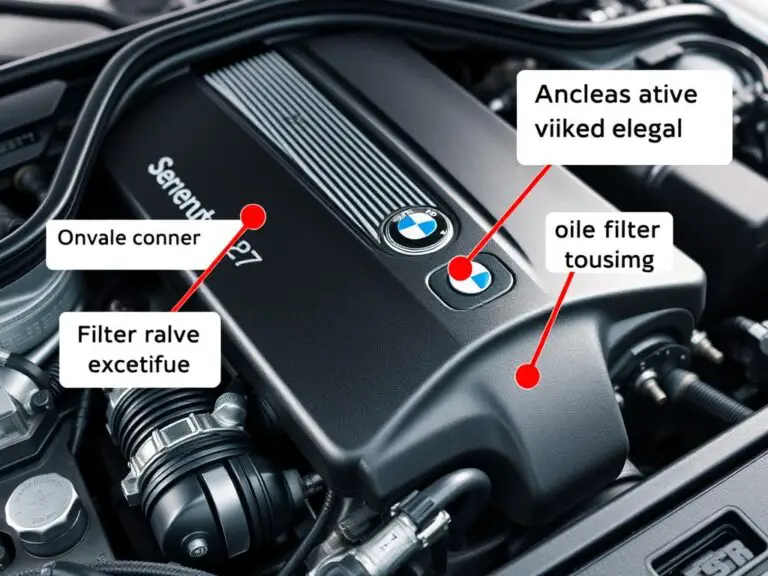A functioning air conditioning system is crucial for a comfortable driving experience, especially in luxury vehicles like BMW. When the BMW air conditioning fails to cool or blow air, it can be frustrating and uncomfortable. Understanding the common issues and signs of BMW AC failure is the first step towards resolving the problem.
Several factors can contribute to BMW AC not working, including faulty components and electrical issues. For a comprehensive diagnosis and repair, it’s recommended to consult a specialist.
Key Takeaways
- Common causes of BMW AC failure include faulty air compressors and Freon leaks.
- Signs of failure include weak air flow, warm air, and air not blowing at all.
- Routine inspection by a German-engineering specialist can prevent failures.
- Electrical switch issues can prevent air from blowing.
- Blower motor or HVAC blower issues can cause weak air flow.
Understanding BMW AC Systems
BMW’s air conditioning systems are sophisticated, comprising multiple parts that work in harmony to provide a comfortable driving experience. The complexity of these systems can sometimes make diagnosis and repair challenging.
Components of a BMW AC System
The BMW AC system consists of several key components, including the compressor, condenser, evaporator, and expansion valve. Each of these parts plays a crucial role in the cooling process.
- The compressor compresses the refrigerant, raising its temperature and pressure.
- The condenser cools the refrigerant, causing it to condense into a liquid.
- The evaporator allows the refrigerant to expand, cooling the air that passes over it.
- The expansion valve regulates the flow of refrigerant into the evaporator.
How BMW AC Systems Differ Across Models
BMW AC systems vary across different models, with variations in design and functionality. For instance, some models may feature dual-zone climate control, allowing for different temperatures on the driver’s and passenger’s sides. Other models might include advanced features like automatic recirculation or air quality sensors.
BMW AC Not Working (Causes, Signs and Solutions) – Overview
AC problems in BMWs can manifest in different ways, from weak airflow to complete system failure. Understanding the causes and signs of these issues is crucial for effective troubleshooting and maintenance.
Most Common AC Issues in BMW Vehicles
Several common issues can lead to BMW AC failure. Refrigerant leaks are a frequent problem, causing the system to lose its cooling ability. Compressor failures are another common issue, often resulting from worn-out or damaged components. Electrical malfunctions, such as faulty wiring or blown fuses, can also disrupt the AC system’s operation.
Regular BMW AC maintenance can help prevent these issues. Checking the refrigerant level, inspecting the compressor and electrical connections, and ensuring proper system function can significantly reduce the risk of AC failure.
Model-Specific AC Problems
Different BMW models may experience unique AC-related issues. For instance, some models may be prone to condenser coil damage, while others might have issues with the cabin air filter or the AC control module. Understanding these model-specific problems is essential for effective BMW AC troubleshooting.
By identifying the specific cause of the AC issue, BMW owners can take the necessary steps to repair or maintain their vehicle’s AC system, ensuring optimal performance and comfort.
Common Causes of BMW AC Failure
The failure of BMW AC systems can be attributed to several key factors that need to be understood for effective troubleshooting. BMW air conditioning issues can arise from a variety of sources, and identifying these causes is crucial for maintaining a comfortable driving experience.
Refrigerant Leaks and Low Pressure
Refrigerant leaks are a common issue in BMW AC systems, leading to low pressure and reduced cooling performance. These leaks can occur due to worn-out seals, damaged hoses, or corroded components. Regular inspections can help identify potential leaks before they cause significant problems.
Compressor and Clutch Failures
The compressor is a critical component of the BMW AC system, responsible for compressing refrigerant to cool the air. Compressor failures can occur due to wear and tear, inadequate lubrication, or electrical issues. The clutch, which engages and disengages the compressor, can also fail, leading to AC malfunction.
Electrical System Malfunctions
Electrical system malfunctions can significantly impact the BMW AC’s performance. Issues such as faulty wiring, blown fuses, or malfunctioning relays can prevent the AC system from operating correctly. Diagnosing electrical problems requires a thorough understanding of the AC system’s electrical components and their interconnections.
To better understand the relationship between these causes and their effects on the BMW AC system, consider the following table:
| Cause | Effect | Common Symptoms |
|---|---|---|
| Refrigerant Leaks | Low Pressure | Reduced Cooling, Ice on AC Components |
| Compressor Failure | No Cooling | Loud Noises, AC Not Engaging |
| Electrical Malfunctions | Intermittent or No AC Operation | Blown Fuses, Faulty Relays |

By understanding these common causes of BMW AC failure, car owners can take proactive steps to diagnose and repair issues, ensuring their vehicle’s AC system operates efficiently and effectively.
Diagnosing BMW AC Problems
Diagnosing AC issues in your BMW involves a combination of visual inspections and technical checks. To start, it’s essential to understand the components of your BMW’s AC system and how they interact.
Step-by-Step Visual Inspection Process
A visual inspection is the first step in diagnosing BMW AC problems. Begin by checking the AC system’s physical components:
- Inspect the condenser coils for dirt or damage.
- Check the refrigerant lines for signs of leaks or wear.
- Examine the compressor clutch for proper engagement.
- Verify that the cabin air filter is clean and not clogged.
Visual inspections can reveal obvious issues that may be causing your AC to malfunction.
Using OBD Scanners for AC Diagnostics
Modern BMWs rely on sophisticated computer systems that can be accessed using OBD-II scanners. These tools can provide valuable insights into the AC system’s performance and help identify problems:
- Connect an OBD-II scanner to your BMW’s OBD port.
- Navigate to the AC system readings to check for fault codes.
- Monitor the system’s pressure readings and temperature sensors.
Using an OBD scanner can help you diagnose complex issues that aren’t apparent during a visual inspection.

Interpreting AC System Pressure Readings
Understanding AC system pressure readings is crucial for diagnosing issues. The pressure readings can indicate problems such as refrigerant leaks or compressor failures:
- Low pressure may indicate a refrigerant leak.
- High pressure could signify a blockage or condenser issue.
- Abnormal pressure fluctuations might point to a compressor problem.
By interpreting these readings, you can narrow down the possible causes of your BMW’s AC issues.
DIY Repairs for BMW AC Issues
Before taking your BMW to a repair shop for AC issues, consider attempting some simple DIY fixes. Many common problems can be resolved at home with the right tools and a bit of knowledge.
Recharging AC Refrigerant
One common issue with BMW AC systems is low refrigerant levels, which can cause the air conditioning to blow warm air. Recharging the refrigerant can often resolve this problem.
Required Tools and Materials
- AC refrigerant recharge kit
- Gloves and safety goggles
- Manometer or pressure gauge
Step-by-Step Procedure
- Locate the low-pressure port on your BMW’s AC system.
- Attach the recharge kit to the port and check the pressure.
- If the pressure is low, add refrigerant according to the kit’s instructions.
- Monitor the system’s performance and pressure readings.
Replacing Cabin Air Filters
A dirty or clogged cabin air filter can reduce the efficiency of your BMW’s air conditioning system. Replacing the filter is a simple process that can improve air quality and AC performance.
To replace the cabin air filter, locate it behind the glove compartment or under the dashboard, depending on your BMW model. Remove the old filter and dispose of it properly. Install a new filter, making sure it is securely in place.
Checking and Replacing AC Fuses and Relays
Sometimes, AC issues can be traced back to blown fuses or faulty relays. Checking and replacing these components is a straightforward DIY task.
Steps to check and replace AC fuses and relays:
- Consult your BMW’s owner’s manual to locate the fuse box.
- Identify the fuses related to the AC system.
- Inspect the fuses for signs of damage or wear.
- Replace any blown fuses or faulty relays with new ones of the correct amperage rating.
Maintaining Your BMW’s AC System for Optimal Performance
Understanding the causes, signs, and solutions for BMW AC issues is crucial for maintaining a comfortable driving experience. By recognizing the common causes of AC failure, such as refrigerant leaks and compressor failures, you can take proactive steps to address problems before they escalate.
Regular BMW AC maintenance is essential to ensure your vehicle’s AC system functions optimally. This includes checking and replacing cabin air filters, inspecting electrical system components, and recharging refrigerant as needed. By staying on top of these tasks, you can prevent many common AC issues and enjoy a cooler, healthier driving environment.
When faced with complex BMW AC troubleshooting, it’s often best to seek professional help. A qualified technician can diagnose and repair issues efficiently, getting your AC system back to its optimal performance. By combining the knowledge gained from this article with regular maintenance and professional assistance when needed, you can enjoy a reliable and efficient AC system in your BMW.
FAQ
What are the most common causes of BMW AC failure?
The most common causes of BMW AC failure include refrigerant leaks, compressor failures, and electrical system malfunctions. Refrigerant leaks can occur due to damaged or corroded components, while compressor failures often result from worn-out or faulty parts. Electrical system malfunctions can be caused by blown fuses, faulty relays, or wiring issues.
How do I diagnose a BMW AC problem?
Diagnosing a BMW AC problem involves a step-by-step visual inspection process, using OBD scanners to check for error codes, and interpreting AC system pressure readings. Start by checking the AC system’s electrical connections, fuses, and relays. Use an OBD scanner to retrieve any error codes stored in the vehicle’s onboard computer. Then, check the AC system’s pressure readings to identify any potential leaks or blockages.
Can I recharge my BMW’s AC refrigerant myself?
Yes, you can recharge your BMW’s AC refrigerant yourself, but it’s essential to follow the correct procedure and use the right equipment. You’ll need a refrigerant recharge kit, which typically includes a can of refrigerant, a charging hose, and a gauge. Follow the manufacturer’s instructions for the recharge process, and ensure you handle the refrigerant safely.
How often should I replace my BMW’s cabin air filter?
It’s recommended to replace your BMW’s cabin air filter every 12,000 to 18,000 miles, or as specified in your owner’s manual. A dirty cabin air filter can reduce airflow, cause unpleasant odors, and potentially lead to AC issues. Replacing the cabin air filter is a relatively simple process that can be done at home.
What are the signs of a faulty BMW AC compressor?
Signs of a faulty BMW AC compressor include a lack of cooling, unusual noises, or vibrations coming from the compressor. You may also notice a decrease in AC performance, or the compressor may not engage when you turn on the AC. If you suspect a faulty compressor, it’s best to have it inspected and replaced by a professional mechanic if necessary.
Can a blown fuse cause my BMW’s AC to stop working?
Yes, a blown fuse can cause your BMW’s AC to stop working. The AC system relies on electrical connections and fuses to function properly. Check your owner’s manual or the fuse box diagram to locate the fuse related to the AC system. If you find a blown fuse, replace it with a new one of the same rating, and test the AC system to see if it’s working correctly.


